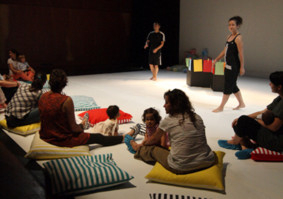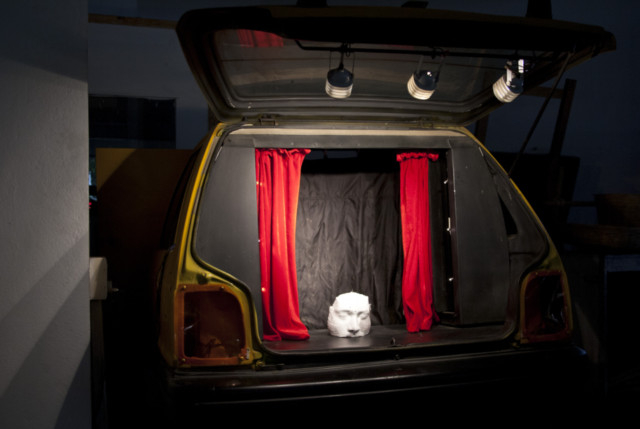
“I can smell it,” announced a 4-year-old boy loudly in a darkened auditorium in Bengaluru, south India, filled to capacity with 3 to 6-year-olds when Swiss puppeteer and storyteller Margrit Gysin pulled out a puppet-mouse Mimi to make tea for her father Brumm, the bear who has been laid up in bed! Not one among the 75 children watching the play found it strange that a Bear had a mouse for a daughter or that he was ordered by a Penguin doctor to drink chamomile tea. The children joined Gysin, a trained puppet therapist from the Swiss Institute for Therapeutic Puppet Theatre, to help make tea and sweep the floor of the puppet theatre. The play held no veiled moral, no secret message about differences and living together, or lectures about forced brotherhood. Nothing was said and yet, in that unifying space called the theatre, everything was understood by the young audience who sang the Bear to sleep and who rejoiced when he recovered from his fever.
Remember the story of how the unborn child Abhimanyu (still in his mother’s womb) — in the “Mahabharata” — overhears a conversation on how to enter the Chakrayuha, the dreaded battle formation? The information would come in handy in the 18-day Kurukshetra war. While that might only be a story from the epics, it has now been proven beyond doubt that the actual development of a child’s faculties begins at conception, and is at its peak until the age of 8. Every message that is received during this period plays a part in how this child develops. What follow in later years are said to be just permutations and combinations of the formulae recorded in the synapses of the infant and the child’s brain. It is these crucial eight years in a child’s life that artistes and educators all over the world have been trying to tap into. The result is an increasing interest in creating an atmosphere that engages the children even as it provides exposure, entertainment and information through the arts. Until recently children’s plays usually meant plays for those above the age of 8. However, today, theatre practitioners are working with much younger age groups more and more, starting with children as young as 7. Circular Theatre, from Portugal, for example, has been travelling the world performing its interactive show where no language is used for children up to 36 months. Devised and performed by Joclecio Azevedo and Teresa Prima the play is like a little game — the actors use simple shapes, sounds and gestures to connect with their infant audiences. And it is not unusual to find little babies gurgling in response to the sounds and actions of the performers.
Can theatre connect with audiences that young? Anne from Schnawwl Theatre, Germany, believes it can. “Even infants must be allowed to participate in what is aesthetic and cultural in society,” she says. “The Great Lalula”, directed by Marecea Herrera and Nicole Libnau, is aimed at toddlers in the age group of 1 to 3. Herrera stresses the importance of research; visiting child care centres and research in child psychology and theatre pedagogy were part of the two-year build-up to creating the play using Christian Morgenstern’s nonsense verse. Using a bucket, sand and vessels the actors engaged the young ones that sat enthralled, participating at every step. “Three days after the show, my 15-month-old daughter continued to say ‘Lalula’ every day during her bath. I don’t know what effect the play had on her, but it sure did something,” says Ranjini Rao, a teacher in Chennai.
With over 2.2 billion children in the world it is only natural that theatre communities and government bodies across the globe have started showing more interest in theatre for children and increasingly for children up to 8 years old. Gone are the days when fairytales from the West were a staple for young children; “Snow White”, “Sleeping Beauty” and “Cinderella” are being sent into deep freeze and replaced by theatre that is relevant, engaging and those that cut across cultural barriers.
First-world countries such as Germany and the United Kingdom spend millions of dollars on researching and creating shows specially aimed at children unlike in developing countries where the expenditure on the arts and on children is negligible. India and China — home to the world’s largest populations of children — have invested little in developing programmes for children, and it has largely been the non-governmental sector behind the rise of children’s theatre in these countries. In other parts of the world, namely affluent Middle Eastern countries and America, a variety of pedagogical programmes that involve theatre for children, especially in the form of workshops and co-curricular activities, have found favour with both educators and parents leading to several arts organisations and cultural institutions working with children.
“How do we conceive of the future of our young audience, and what will we produce for them in the future?” asked Dr Gerd Taube, the artistic director of Augenblick Mal, the biennale of children’s theatre in Germany. It is a serious question that artistes and governments across the world would do well to ask themselves. Theatre, with its role-playing and make-believe world, is said to come closest to the creative direction taken naturally by children whose growing-up years invariably involve making up stories and imaginary friends. “The arts are the first languages of children across the world,” says Dr Aparna Bhattacharya, whose book “Theatre for Children” will hit the stands later this year. “Theatre — the imagined and enacted world of humans — is one of the primary ways children at an early age learn about life, actions, consequences, customs and beliefs, both their own and that of others.” She stresses on issues that have been responsible for introducing arts and theatre in schools across the world; that research has proven time and again that exposing children to theatre helps develop cognitive faculties, besides helping create sensitive, responsible, expressive human beings.
The flip side to the increasing interest in children’s theatre is the onslaught of indifferent commercial theatre productions that only look at children as a burgeoning market, with schools forming a big segment of that market.
Due to the lack of support from the government, apathy from the private sector and limited grant-making institutions and research facilities, schools and theatre groups regularly stage the famed musicals, which are mostly poor imitations of Broadway and West End shows. The National School of Drama’s annual festival for children Jashn-e-Bachpan (Delhi), Prithvi Theatre’s Summertime Children’s Plays (Mumbai) and Ranga Shankara’s Aha! Festival for Children (Bengaluru), supported by Britannia Industries, are notable exceptions. This year Ranga Shankara took its children’s programme outside the auditorium with a new puppet theatre titled “Maruti Theatre” — so named because it is performed in the boot of a Maruti Suzuki car that has been salvaged from scrap. Actor, director and teacher Padmavati Rao created a new show based on the story of Keshav Lal, a man who is losing his hair and fast. What seems like an older person’s nightmare becomes a young child’s concern too, as 40 children aged 3 to 5 sit inside a tent following the antics of Keshav Lal. Special lights, costumes and sounds enthral and entertain very young children. As we wait for the show to begin, 3-year-old Anindita shyly asks her mother, “Is a play a movie that happens for real?”
The reach of cinema is universal but a live interactive performance is one that can leave an indelible mark on a child. In the play “Taming of the Wild” performed by Doll’s Theatre, Kolkata, as part of the Ranga Shankara festival a mean puppet with a saw tries to cut a tree that is home to many birds when a young voice cries out from the audience, “Uncle, please don’t cut it.” This is followed by a chorus of 300 voices pleading inside the auditorium, “Uncle, please don’t cut the tree, please ... we beg of you.” Many adults in the present begin shedding tears, not so much at the play as at the spontaneous reaction of the children. It is moments like these that artistes across the world hope to create — moments that reinstate the magic of immediacy in the theatre for children.
Nirmala Ravindran is a writer based in Bengaluru, India.
Photographs: Virginia Rodrigues












